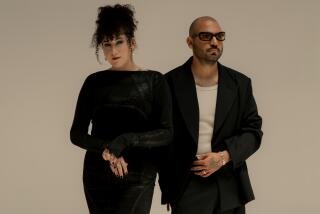The Kitsch Niche : Ever Wonder What Zoot Suits and Eiffel Tower Ashtrays Have in Common?
LOS ANGELES IS the capital of kitsch. We create it. We cherish it.
The dictionary defines kitsch as “art of a pretentious but shallow kind, calculated to have a popular appeal.”
I’d not call it art but an artifact that pretends, sometimes playfully, to be art. It is, essentially, a product of bad taste.
Defining good taste and bad taste is not easy. Like beauty, they are in the eye of the beholder. But bad taste is a liking for anything that is fake, shoddy, cheap, imitative, gaudy, ersatz or false.
Objects designed to perform incongruous functions are kitsch: for example, windmill restaurants, dolls that are radios, statues that are ash trays.
Miniatures of historic works are kitsch. We buy them by the thousands in tourist traps around the world: Eiffel Towers, Egyptian pyramids, Michelangelo’s Davids, Mona Lisas.
Kitsch of the worst kind are those hideous reproductions of the Last Supper sold by peddlers to tourists lined up at the Mexican border in Tijuana. They represent the triumph of faith over taste.
Los Angeles is the Valhalla of architectural kitsch. We have had lunch stands in the shape of hot dogs, pet shops in the shape of dogs, camera shops in the shape of cameras, a diner enclosed in an airplane. The Egyptian Theatre remains from the architectural craze for things Egyptian caused in the 1920s by the discovery of King Tut’s tomb.
In “Day of the Locust,” Nathanael West described the pervasive kitsch of houses in the Hollywood Hills. “Not even the soft wash of dusk could help the houses. Only dynamite would be of any use against the Mexican ranch houses, Samoan huts, Mediterranean villas, Egyptian and Japanese temples, Swiss chalets, Tudor cottages, and every possible combination of these styles. . . .”
What is art in one setting may be kitsch in another. The Taj Mahal may be one of the world’s most beautiful structures, but when a movie mogul builds a replica of it in Beverly Hills, that is kitsch.
In “The Encyclopedia of Bad Taste” (HarperCollins) Jane and Michael Stern examine about 120 different categories of kitsch, from accordion music to zoot suits, including enormous breasts, discos, Forest Lawn, heavy metal, lawn ornaments, limousines, Jayne Mansfield, Muzak and roller derbies.
The joy of kitsch infects us all. On a bookshelf visible from my desk sits my plaster-of-Paris Maltese Falcon, copies of which were passed out liberally by a Hollywood producer in 1975. His black paint has chipped here and there, but I love him.
In the little walled garden outside my wife’s bathroom, a life-size plastic unicorn sits. There is an oblong opening in his back for a potted plant.
The Sterns link unicorns with rainbows as objects of kitsch. “Keeping the image of a unicorn and/or rainbow nearby provides steady reassurance that you are not a mundane individual who leads a drab life.”
I should note that it was I, not my wife, who bought the unicorn. I want to make it clear that she is not a mundane individual who leads a drab life.
Our most treasured piece of kitsch is the cement fountain that is visible through our living room picture window. A slender nymph, her breasts bare above a flimsy robe, stands in a large water bowl, holding aloft a dish from which water spills over her body and into the bowl below.
When they were in high school, our two sons gave it to us for Christmas. With much grunting and shuffling of feet, they installed it on Christmas Eve while we pretended not to notice.
Kitsch it may be, but not to our eyes.
I take exception to the Sterns’ listing of Jayne Mansfield as an object of kitsch. They note her spectacular figure and her vigorous self-promotion. “Instead of talking, she purred and squealed and sighed seductively; instead of walking, she perfected an astounding stiletto-heeled gait that hurled her hips sideways and started the famous breasts jiggling. . . .”
I can’t say that I knew Jayne, but I met her several times, once at her Beverly Hills home (with the heart-shaped swimming pool) when she was entertaining the San Francisco Giants baseball team after a Dodger Stadium game. With charming propriety, she denied her guests alcohol but took me into her bar and mixed me a vodka tonic. I was just a reporter, not an athlete.
Among my cherished souvenirs is a photograph of Jayne showing me a bruise on her upper thigh.
Now that’s kitsch.






